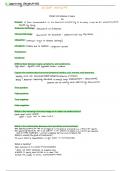Summary
PHAR121 Module 1 Summary
- Course
- PHAR 121 (PHAR121)
- Institution
- University Of Saskatchewan (USask )
A summary of all material that is important for Module 1 for PHAR121. Material is organized and most important aspects needed to know for the exam are highlighted.
[Show more]



